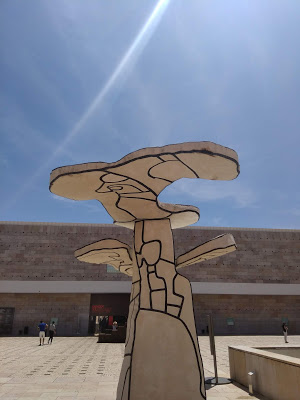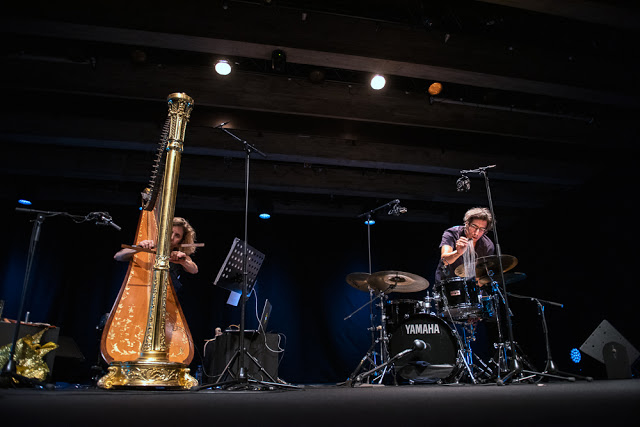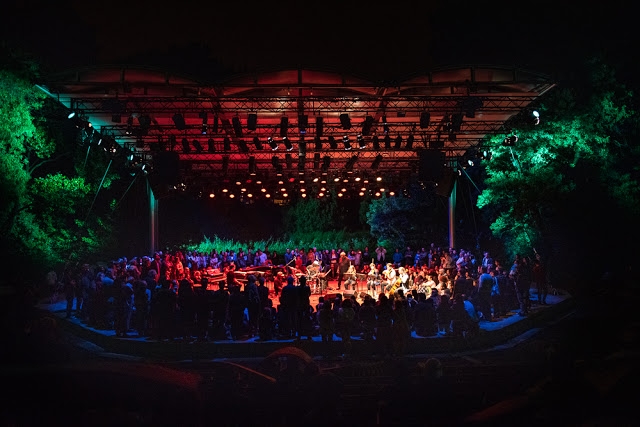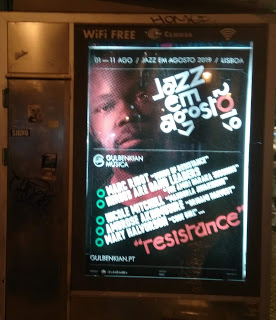By Paul Acquaro
8/10/2019, Lisbon
Sometimes a little context can go a long way. On Friday afternoon, I took the 15 Tram to the neighborhood of Belem. Located about where the Tagus river (on which Lisbon sits) meets the Atlantic Ocean, it is home to several sights, including the 16th century river fortress Torre de Belem, the Padrão dos Descobrimentos monument dedicated to the 15th-century Portuguese explorers, the ornate and imposing Mosteiro dos Jeronimos, and the mid-century modern Gulbenkian Planetarium. These are all great sights worth the 1.5 Euro fare to get to.
 |
| Museu Coleção Berardo |
 |
| Zeena Parkins and Brian Chase © Jazz em Agosto / Petra Cvelbar |
After the set, I had chance to have dinner with the fine folks of ERIS 136199. Acquaintances from New York City, I was happy to have a moment to talk with them about their music and maybe more importantly, the show we had just seen. When someone asked me what I thought of the show, I realized I wasn’t ready yet to answer. I had seen Chase play one drum for about 20 minutes in a couple different ways, then Parkins extract otherworldly sounds from a huge classical harp, and finally Parkins rubbing the harp to produce different tones, and Chase inverting the drums in his set as he played.
Then someone else offered an opinion, “I think Brian is just amazing. He focuses on an idea, taking just one drum, and trusting the space, the room, the instrument just make sounds you didn’t even know were there.” I’m paraphrasing because I didn’t take notes as I was shoving my dinner down, but with the simple explanation, it all snapped into place. Indeed, it was a really good, explorative show from two sympathetic and unshrinking musicians.
 |
| Ambrose Akinmusire Origami Harvest © Jazz em Agosto / Petra Cvelbar |
I came to trumpeter Ambrose Akinmusire Origami Harvest‘s show in the amphitheater without expectations and left running up the wet stairs to the merch table to make sure I could buy a CD before they sold out. Before the affirming moment when Akinmusire, noticing people starting to crowd under the heavy canopy of the trees towards the back of the stage, beckoned them to come under the cover the ample stage instead, I had been converted. However, the intimate circle of the audience around the musicians as they finished their inspired set, was itself inspiring. A fellow next to me said “Woodstock, 1969, Jazz em Agosto, 2019”. A bit heavy handed, sure, but simple and true.
On stage to Akinmusire’s left was drummer Justin Brown, rapper Kokayi, and the Mivos string quartet, to his right pianist and electronics manipulator Sam Harris (see below for the full list of names). Akinmusire has a warm tone, and he opened the show with gentle melody with minimal piano accompaniment. Soon the oscillator kicked in, creating a deep vibration and Koyaki began with a mix of rap and singing. He has a high voice which both stood out and melded with the band. Adding some gentle string accompaniment, the trumpeter had a lush bed of tones to lay his melodies upon.
This strong blend of musical elements, with enough time for each to showcase their strengths, gave the show variety and momentum. The texts poured forth in often urgent, rhythmic ways, with Kayoki playing with syllables and disconnected words. This was the point where I decided to buy the recording, I wanted to understand the words better, as they often went by quickly. However, the message was delivered strongly towards the end when Kayoki implored “say their names … Treyvon Martin, Sandra Bland, Eric Garner …” Of course there was much more said, but the struggle of racism and injustice was clear.
The night came to a close, as mentioned, intimately, as the rain continued lightly through the evening.
 |
| The crowd joins the musicians on stage, escaping the rain © Jazz em Agosto / Petra Cvelbar |
Origami Harvest:
Kokayi – Rap
Justin Brown – Drums
Sam Harris – Piano / Keyboards
Mivos Quartet:
Olivia de Prato – Violin
Maya Bennardo – Violin
Victor Lowrie Tafoya – Viola
Tyler J. Borden – Cello
Index of posts for Jazz em Agosto 2019:
Day 1: https://www.freejazzblog.org/2019/08/jazz-em-agosto-2019-day-1.html
Day 2: https://www.freejazzblog.org/2019/08/jazz-em-agosto-day-2.html
Day 3: https://www.freejazzblog.org/2019/08/jazz-em-agosto-day-3.html
Day 4: https://www.freejazzblog.org/2019/08/jazz-em-agosto-day-4.html
Day 5: https://www.freejazzblog.org/2019/08/jazz-em-agosto-day-5.html
Day 6: https://www.freejazzblog.org/2019/08/jazz-em-agosto-day-6.html
Day 7: https://www.freejazzblog.org/2019/08/jazz-em-agosto-day-7.html
Day 8: https://www.freejazzblog.org/2019/08/jazz-em-agosto-day-8.html


